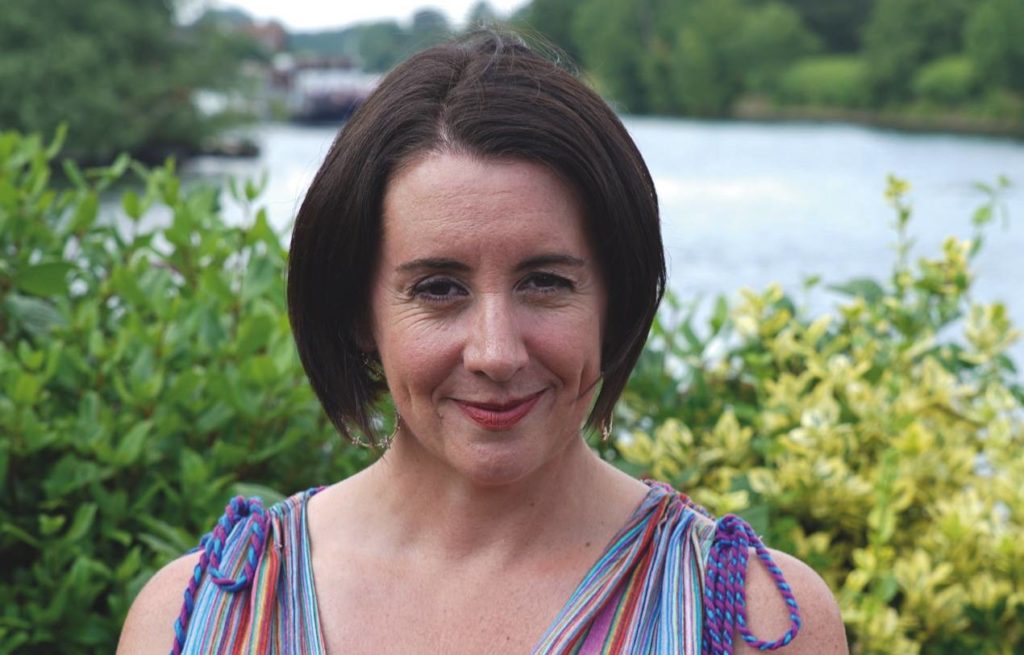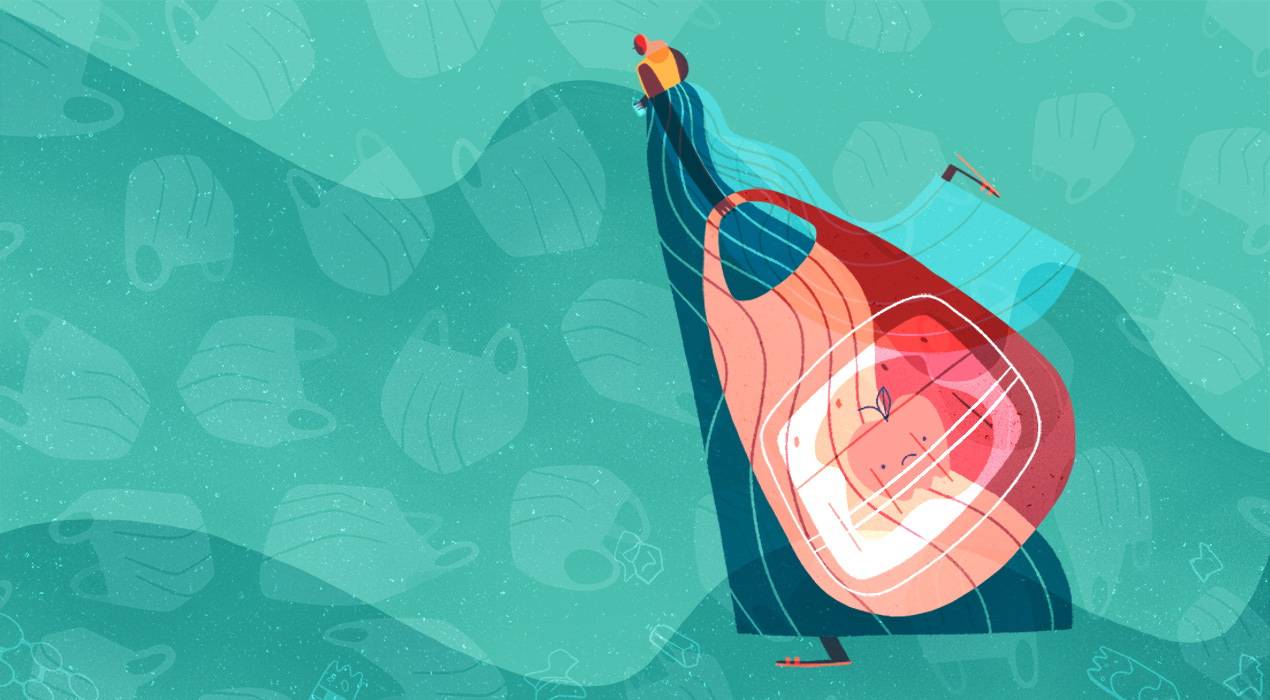Around the waste
Researchers are keenly looking for alternatives to damaging plastic packaging, but without changes in legislation and consumer attitudes, can the scourge of plastic waste ever be banished?
As we become ever more wary of pointless plastics, food companies known for using excessive packaging are under pressure to change their ways. They’re now starting to invest in alternatives, looking at using anything from ground-up lobster shells and rice husks to brand new graphene composites. But is this really going to help save the planet?
“The graphene membrane would allow food to breathe naturally but would stop the food from deteriorating.”
We’ve known for years that food packaging, especially plastic, is extremely harmful to the environment. The food industry is often singled out as a particularly big contributor to the problem, but many large food retailers in the UK have been dragging their feet when it comes to finding alternatives. Until now.
More people than ever are demanding that supermarkets and other retailers do more to stop the endless tide of plastic that ends up in the world’s landfills and oceans. The tipping point came when the BBC aired its Blue Planet II TV series late last year, showing the shocking amount of damage plastic is causing to marine life worldwide. It revealed that there are some 46,000 pieces of plastic in every square mile of ocean.
Even environment secretary Michael Gove claimed to be “haunted” by the BBC’s images of plastic-entangled sea creatures and their ruined environments, and pledged that something would be done. Soon afterwards, in January, Theresa May announced measures to eliminate all “avoidable” plastic waste within 25 years.
Retailers responded quickly too. Iceland was quick to announce plans to go plastic-free on packaging for all of its own label products within the next five years, and Asda is aiming to reduce the amount of plastic packaging used by 10 percent this year.
Every little may help, but environmental groups criticise the government’s plan as “weak” and say business pledges don’t always become reality.
“It’s good to see businesses taking their own steps to eliminate plastic pollution, but the issue with pledges and aims is that there’s nothing to ensure targets are actually met,” Emma Priestland, plastic-free campaigner at Friends of the Earth, tells Big Issue North.
For many food companies, eradicating most plastics should be pretty straightforward. But experts say the chilled and frozen food sector is going to struggle most. When large food retailers have attempted to remove plastic packaging in the past, trials have usually resulted in a large increase in food wastage due to it spoiling in store, and trials were quickly stopped.
But now researchers and innovators are coming up with all kinds of new packaging products that could solve this problem, providing smarter ways of storing food without needing to rely on plastic.
Researchers at Manchester University say new materials made using graphene could be the way forward, allowing retailers to safely package food without relying on plastic.
The National Graphene Institute is now looking at new ways to use graphene and other 2D materials for food packaging, among other uses. “Graphene has many properties that could provide benefits, either in finding a replacement for existing packaging, such as with new membrane technology, through to altering the properties of existing materials – for example creating thinner plastics,” says James Baker, CEO of Graphene@Manchester.
He points out the potential to exploit the membrane properties of graphene. “The graphene membrane would allow food to breathe naturally but would stop the food from deteriorating.”
Manchester University’s recently completed £60 million Graphene Engineering Innovation Centre (GEIC), opening later this year, will allow the researchers to speed up their work, and it will run workshops aimed at the packaging and food industry, which Baker says has already shown an interest.
But whatever the material, Priestland says, food packaging “needs to move towards more reusable, longer lasting alternatives and away from any single use”.
She points out that designers of any type of new packaging product need to consider end of life options, such as how the product will be reused, recycled or disassembled.
While graphene has advantages over plastic, it’s hard to say just yet how much more environmentally-friendly these new materials would be, or exactly how recycling would work.
“Graphene is fundamentally made from carbon, which is a naturally occurring material in the ground, in the air and in the body,” explains Baker. “There are however many forms of graphene material and consideration is needed as to how this is used in a particular packaging application.”
Meanwhile, entrepreneurs around the world are coming up with new food packaging materials using natural materials, including food industry by-products.
Packaging made using everything from ground-up seafood shells to cultivated fungus is now being trialled in the US, and an Australian company called Apiwraps is successfully selling natural beeswax and cotton food wraps, inspired by oilskin wraps used in the past.
Here in the UK, a company called Huskup has created reusable coffee cups made from rice husks, an abundant waste material which its designers say is completely biodegradable.
“Through my previous work in the packaging sector I saw first hand the shocking and unnecessary amount of single use plastic that is cast off,” says Huskup founder Richard Milton. “Thankfully disposable culture has had its day.”
But despite recent changes, retailers say sales of ready meals, lunchtime meal deals and other plastic-heavy items are still going strong. And retail experts say a large scale shift away from plastic packaging will be impossible without a big shift in shoppers’ attitudes to plastic. Shopping at independent grocers rather than supermarkets is a highly effective way to avoid excessive plastic packaging – but not everyone has such shops on their doorstep.
“We’re starting to see possible alternatives emerge from all over the world, from edible spoons to liquid wood,” says John Zealley, senior managing director for product strategy at management consultancy Accenture. “Yet freeing the world from plastic packaging requires a major consumer behaviour change.”
Priestland maintains that strong legislation is what’s needed to push that change.
“We’ve seen before with things like the plastic bag ban that legislation leads to changes in consumer behaviour and also forces companies to innovate new solutions,” she says. “Ultimately we need the UK government to take a far stronger stance against plastic pollution. The current commitment to phase out non-essential plastic in 25 years is far too weak – the damage to our planet is being done now.”
Main illustration: Steph Coathupe
Environmental writer Lucy Siegle has some advice for anyone seeking to cut out plastic from their life

My strategy is based on 8Rs: Record; Reduce; Replace; Refuse; Reuse; Refill; Rethink; Recycle. Here’s a quick version to get you started.
Record it
Write down your plastic consumption for a week. Use a section on your phone or a good old-fashioned notebook to keep a list every time plastic comes in to your life. Every plastic straw and drinks bottle, every crisp bag and chocolate wrapper (all contain plastic) should be noted!
Reduce
Take a look at your list. Wow! You’ll be shocked just how much plastic sneaks into your life without you asking for it. Be aware of hidden plastics. Chewing gum might make your breath feel nice and minty, but it is made of a type of plastic; tea bags also have plastic in them. Take any opportunity to say “no”. Do you shop online or use a food delivery service sometimes? Are there any boxes you can tick that offer a plastic-free option (especially for plastic cutlery and sauce sachets)?
Replace
“Do you have that without plastic?” That’s the question we need to ask everywhere, every time. Wherever you can swap for a non-plastic version, go for it! Cotton buds with plastic stems for example are a true ocean pest. But you can get versions with paper stems. Swap the plastic out, and the alternative in.
Refuse
Master the art of politely saying “no”. Always refuse plastic carrier bags. I refuse all sorts of plastic in stores. I politely ask the sales assistant to keep any plastic wrapping as I don’t want to let it into my trash can at home, where I know it will be difficult to recycle.
Reuse
If you do buy plastic, assess whether there’s any reuse value in the packaging. I don’t, for example, fancy your chances reusing a sandwich wrapper. But a nice sturdy tub – well, that’s a different matter. If it has a good seal and is of a more rigid plastic you can use it for leftovers for the fridge or freezer, at meat and fish counters, or for packed lunches instead of Tupperware. I also re-use empty standard water bottles. Write your name on the bottle, so it doesn’t get thoughtlessly chucked in the trash.
Refill
Grab yourself a reusable water bottle. There’s no excuse. Water fountains have popped up across the UK and many major outlets will now refill your bottle for free. If you’re an on-the-go coffee drinker, you need a KeepCup. Remember standard coffee cups might look like paper and therefore suggest they can be easily recycled but they are lined with plastic.
Rethink
When you’re on the trail of plastic you need to rethink behaviour, especially “convenient” behaviour that creeps in over time. Remember when wet wipes were just for festivals? Now we use billions of them, and they have become part of everyday skincare routines. It’s time to kick them out. They are made of plastic and should never be flushed down the loo. Rethink and replace with a reusable muslin cloth (add tea tree or essential oils).
Recycle
Treat recycling as a last resort by following all the other Rs first! Don’t assume anything plastic can be recycled. Help your recyclers out as much as you can. Follow the rules around your collection and sorting days carefully. Do rinse out your plastics. But don’t be too tidy. I find many people fold straws and crisp bags and other rubbish into bottles and tubs. This contaminates them! Keep all items apart.
Turning The Tide On Plastic: How Humanity (And You) Can Make Our Globe Clean Again by Lucy Siegle is published by Trapeze in hardback

Leave a reply
Your email address will not be published.